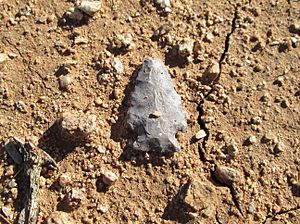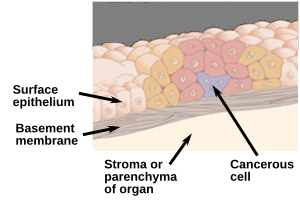In situ facts for kids
In situ is a Latin phrase that means "on site" or "in place." It describes something happening right where it is, without being moved. Think of it as "right here." This phrase is used in many different areas, like science, art, and engineering. The opposite of in situ is ex situ, which means "off site" or "away from its original place."
Contents
- In Aerospace: Testing Planes in Place
- In Archaeology: Discovering History Where It Lies
- In Art: Art Made for Its Place
- In Astronomy: Planets Forming Where They Are
- In Biology: Studying Life in Its Natural State
- In Chemistry: Reactions in the Mixture
- In Civil Engineering: Building on Site
- In Computer Science: Working Without Stopping
- In Earth Sciences: Processes in Nature
- In Environmental Cleanup: Cleaning Where It Is
- In Medicine: Understanding Health and Illness
- In Mining: Extracting Resources in Place
- In Petroleum Production: Getting Oil from Underground
- In Space: Using Resources from Space
- In Urban Planning: Improving Neighborhoods
- In Vacuum Technology: Cleaning in Place
- Roadside Assistance: Fixing Cars on the Spot
- See also
In Aerospace: Testing Planes in Place
In the aerospace industry, in situ means testing equipment directly on an aircraft. This is important because even if each part works alone, they might have problems when put together. Testing them in situ helps make sure everything works correctly as a whole system. It can also mean fixing parts of the aircraft without taking them off.
In Archaeology: Discovering History Where It Lies

In archaeology, in situ means an artifact (like an old tool or pot) has not been moved from where it was first left. Finding an artifact in situ is super important. It helps archaeologists understand how people lived long ago. Once its spot is recorded, the artifact can be moved for study or display.
If an artifact is not found in situ, it's harder to know its story. It might have been moved by people, animals, or even nature. For example, some ancient sculptures, like the Sphinx, were carved in situ, meaning they were made right where they stand today.
In Art: Art Made for Its Place
In art, in situ means a work of art was made especially for a certain place. It fits perfectly with its surroundings. This is also called Site-specific art. It can also mean an artist created the artwork right where it will be shown, instead of in their studio. For example, a sculpture carved directly onto a building is in situ.
In Astronomy: Planets Forming Where They Are
In astronomy, in situ can describe how planets form. It suggests that planets form at the distance from their star where we see them now. This is different from the idea that they might have moved from another orbit.
In Biology: Studying Life in Its Natural State

In biology, in situ means studying something exactly where it naturally occurs. For example, observing a wild animal in situ means watching it in its natural habitat. You don't move it to a zoo or aquarium.
In a lab, in situ can mean studying cells within a whole organ that is still intact. This is different from studying cells alone in a dish (in vitro) or within a living body (in vivo).
In situ conservation is also very important. It means protecting endangered plants or animals in their natural homes. This is often better than moving them to a special facility (ex situ conservation).
In Chemistry: Reactions in the Mixture
In chemistry, in situ usually means something happens "in the reaction mixture." This is often done when a chemical is unstable and can't be stored. So, it's made right when it's needed during a process.
In Civil Engineering: Building on Site
In architecture and building, in situ refers to construction done directly at the building site using raw materials. Think of pouring a concrete slab right there. This is different from prefabricated construction, where parts are made in a factory and then brought to the site.
In situ methods often take more time and labor, but the materials can be cheaper. They are also more flexible. Prefabricated methods are quicker but can be more expensive and less flexible.
In Computer Science: Working Without Stopping
In computer science, in situ can mean doing something without stopping the system. For example, an in situ upgrade means updating a computer's operating system while it's still running. This might not even require a restart!
An in situ algorithm is a special type of computer program that uses very little extra memory. It changes data directly where it is stored, instead of making copies. For example, the heapsort algorithm sorts a list of items right in their original place.
When you edit an image directly within a word processor without opening a separate image editor, that's called in situ editing.
In Earth Sciences: Processes in Nature
In physical geography and Earth sciences, in situ describes natural materials or processes before they are moved. For example, weathering happens in situ (rocks breaking down in place), while erosion involves movement by wind or water.
In atmospheric sciences, in situ means taking measurements directly. A radiosonde measures air directly, unlike radar which measures from a distance.
In Environmental Cleanup: Cleaning Where It Is
In situ in environmental cleanup means cleaning up a polluted site right where the pollution is. This often involves using natural processes in the soil. This is different from ex situ cleanup, where contaminated soil is dug up and cleaned somewhere else.
In Medicine: Understanding Health and Illness
In medicine, especially in cancer studies, in situ means that harmful cells are present but have not spread to other parts of the body. For example, a carcinoma in situ is a tumor that has not grown beyond its original tissue layer. These tumors can often be removed with surgery.
In anatomy, in situ means looking at body parts as they appear in a normal, healthy body. For instance, a doctor might look at the liver in situ inside the body, rather than looking at a liver that has been removed.
In Mining: Extracting Resources in Place
In situ leaching or in situ recovery is a mining method. It involves injecting a liquid underground to dissolve valuable minerals. This liquid, now carrying the minerals, is then brought back to the surface for extraction. This method is often used for uranium mining.
In Petroleum Production: Getting Oil from Underground
In situ in petroleum production refers to ways of getting heavy crude oil or bitumen from deep underground. This is done by applying heat (like steam) or solvents directly into the oil reservoirs. One common method is called SAGD (steam-assisted gravity drainage).
In Space: Using Resources from Space
Future space missions might use in situ resources. This means using materials found directly on the Moon or Mars to make fuel or supplies. For example, the Mars Direct mission concept plans to make fuel on Mars using the Sabatier reaction.
In space sciences, in situ also means measuring the environment around a satellite directly. This could be detecting energetic particles in the solar wind or measuring magnetic fields.
In Urban Planning: Improving Neighborhoods
In urban planning, in situ upgrading is a way to improve informal settlements (like slums) right where they are. This helps people living there get better services and living conditions without having to move.
In Vacuum Technology: Cleaning in Place
In vacuum technology, in situ baking means heating parts of a vacuum system while it's under vacuum. This helps remove unwanted gases or substances from the walls, making the vacuum cleaner.
Roadside Assistance: Fixing Cars on the Spot
When you hear "repair in situ" for a car, it means fixing the vehicle right where it broke down. The mechanic comes to you, instead of towing the car to a garage.
See also
 In Spanish: In situ para niños
In Spanish: In situ para niños
- carcinoma in situ
- ex vivo
- in silico
- in vitro
- in vivo
- In situ conservation
- Ex situ conservation
- List of Latin phrases
- All pages beginning with In situ


